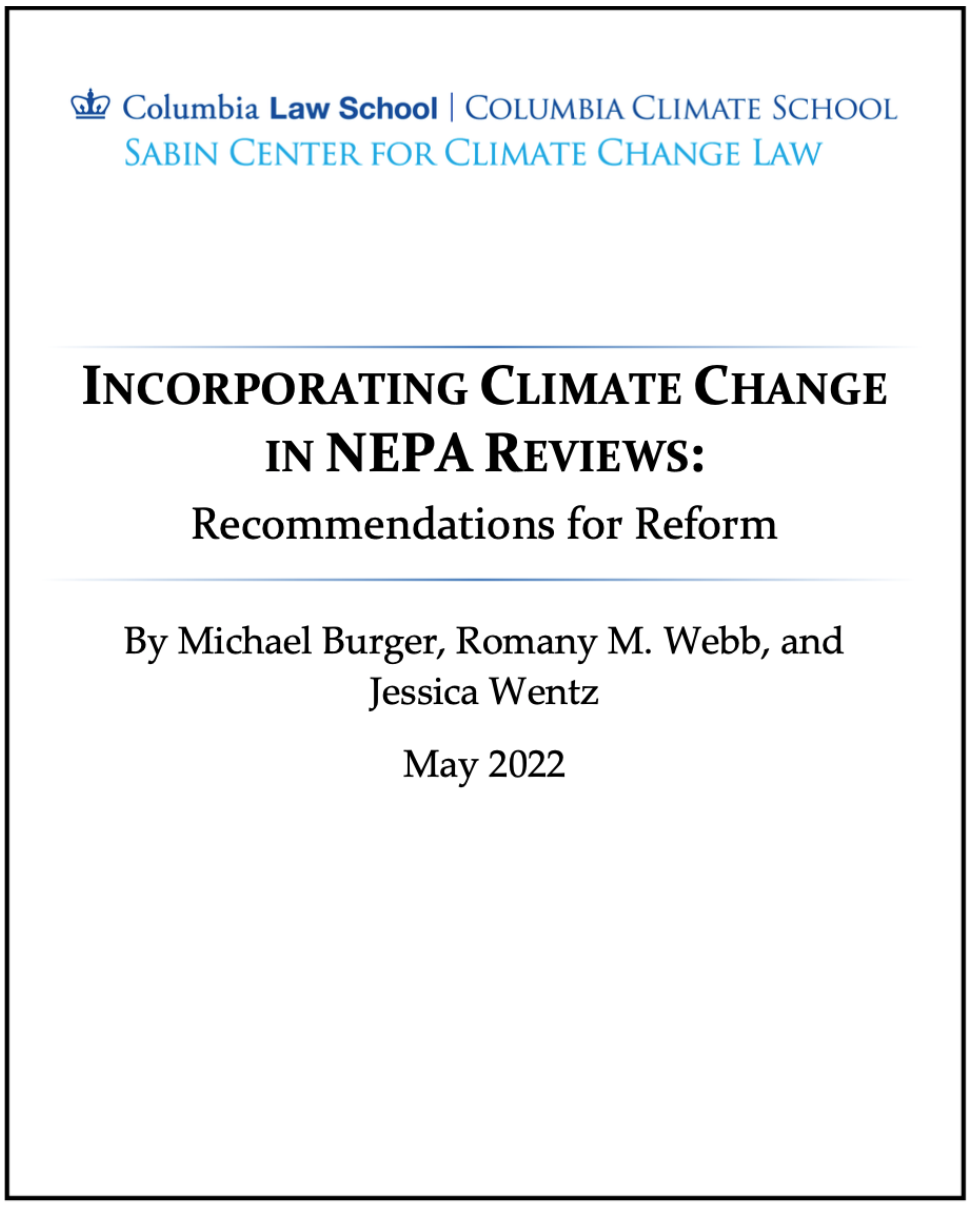By Jessica Wentz
On December 28, 2018, California adopted comprehensive amendments to the California Environmental Quality Act (CEQA) Guidelines, which include a suite of provisions aimed at improving the analysis of greenhouse gas (GHG) emissions and climate change impacts in state environmental reviews. These provisions touch on both climate change mitigation and adaptation, providing more detailed guidance on topics such as assessing the significance of GHG emissions, analyzing energy impacts and efficiency, estimating vehicle emissions, and evaluating environmental risks in light of a changing and uncertain baseline. These amendments flesh out many of the provisions on climate change and energy that were first added to the CEQA Guidelines in 2010.
GHG Emissions Analysis
The CEQA Guidelines have been revised to clarify the appropriate methodology for measuring and assessing the significance of GHG emissions, consistent with recent case law. Specifically, Section 15064.4, “Determining the Significance of Impacts from Greenhouse gas Emissions”, has been updated as follows:
First, discretionary language has been replaced with mandatory language to clarify that the GHGs analysis is a required component of CEQA. A provision stating that lead agencies “should” make a good faith effort to estimate or describe a project’s GHG emissions has been revised to provide that agencies “shall” make this effort. Similarly, a provision directing agencies to “assess” the significance of emissions has been amended to provide that agencies should “determine” the significance of emissions – the idea being that agencies must issue a final significance determination for emissions (something that has been noticeably absent from both state and federal environmental reviews in recent years). This is particularly important in the CEQA context, since CEQA requires mitigation to the extent feasible for significant impacts.
Second, the factors for evaluating the significance of GHG impacts have been updated to clarify that the focus should be on the project’s total contribution to climate change rather than how the emissions compare to statewide or global totals. Section 15064.4(2)(b) now provides that:
“In determining the significance of a project’s greenhouse gas emissions, the lead agency should focus its analysis on the reasonably foreseeable incremental contribution of the project’s emissions to the effects of climate change. A project’s incremental contribution may be cumulatively considerable even if it appears relatively small compared to statewide, national or global emissions. The agency’s analysis should consider a timeframe that is appropriate for the project. The agency’s analysis also must reasonably reflect evolving scientific knowledge and state regulatory schemes.”
The revisions also clarify that lead agencies may consider a project’s consistency with the state’s “long-term climate goals or strategies” when evaluating significance, but any finding of no significant impact predicated on consistency must be supported by “substantial evidence… of how those goals or strategies address the project’s incremental contribution to climate change and its conclusion that the project’s incremental contribution is not cumulatively considerable.”
Third, the revised guidelines clarify that the lead agency has discretion to select a model or methodology that it considers most appropriate for estimating GHG emissions, but that it must “support its selection of a model or methodology with substantial evidence” and “explain the limitations of the particular model or methodology selected for use.”
One goal of these new provisions is to ensure that CEQA reviews are consistent with recent case law on consideration of GHG emissions, cumulative impacts, and significance determinations. See, e.g., Center for Biological Diversity v. Dept. of Fish & Wildlife, 62 Cal.4th 204 (2015) (invalidating EIR because agency determination that project’s emissions were consistent with statewide emission reduction goals and therefore insignificant was not supported by a reasoned explanation based on substantial evidence); Friends of Oroville v. City of Oroville, 219 Cal.App.4th 832 (2013) (invalidating EIR that based its significance determination partly on comparing the project’s emissions to statewide emissions).
Energy Impacts and Efficiency
The revised guidelines incorporate a new subdivision on energy impacts (Section 15126.2(b)), which clarifies that CEQA requires consideration of whether a project will result in significant environmental effects due to “wasteful, inefficient, or unnecessary consumption of energy” and states that agencies “shall mitigate” any wasteful energy use giving rise to significant impacts. With regards to the scope of the analysis, the new subdivision states that the analysis “should include the project’s energy use for all project phases and components, including transportation-related energy, during construction and operation.” It also clarifies that building code compliance should not be the sole consideration in this analysis as it does not necessarily indicate whether the particular project’s energy use will be significant or could be improved; agencies should also consider project size, location, orientation, equipment use, and any renewable energy features that could be incorporated into the project. Finally, the new subdivision cautions that the energy impact analysis is subject to the rule of reason and should focus on energy demand caused by the project. The California Natural Resources Agency (CNRA) has explained that this sentence is intended to signal that a “full ‘lifecycle’ analysis that would account for energy used in building materials and consumer products will generally not be required.”
The revised guidelines also add “energy” as an impact category in the environmental checklist for CEQA reviews that agencies use to format and guide their environmental reviews (Appendix G). In addition to directing agencies to assess the significance of energy impacts and waste, the checklist asks agencies to consider whether the project might “conflict with or obstruct a state or local plan for renewable energy or energy efficiency?”
Transportation and Vehicle Emissions
California SB 743 (2013) required the state to develop alternative methods of measuring transportation impacts under CEQA that would “promote the reduction of greenhouse gas emissions, the development of multimodal transportation networks, and a diversity of land uses.” Pursuant to this mandate, the revised guidelines introduce a new methodology for calculating and assessing the significance of transportation GHG emissions based on vehicle miles traveled (VMT), rather than level of service (LOS) (the previous metric which dominated CEQA assessments of transportation impacts and significance). Whereas LOS focuses on the acceptability of roadway congestion, VMT measures the actual distance traveled by vehicles and can more easily be used to develop emissions estimates for GHGs and conventional air pollutants (as well as related metrics such as fuel consumption).
New section 15064.3 contains guidance on measuring VMT for transportation and land use projects and using these estimates to gauge the significance of those projects. It clarifies that the primary environmental consideration for transportation impacts is the amount and distance that a project might cause people to drive, and thus reviews should focus on two measures of transportation impacts: auto trips generated and VMT. It also clarifies that automobile delay is not itself a significant effect on the environment (although this may contribute to idling emissions and inefficiencies in vehicle use which could have a significant environmental effect).
The environmental checklist in Appendix G has also been updated with new transportation questions aimed at ensuring agencies focus on evaluating impacts on VMT pursuant to these new requirements.
While many of the revisions are effective immediately, the new VMT methodology will not be mandatory until July 1, 2020 to give agencies time to prepare for the new analysis (e.g., by developing VMT-based thresholds for significance or by creating VMT mitigation banks to offset VMT increases from new development).
Climate Change Impacts, Adaptation, and Adaptive Management
The revised guidelines incorporate several provisions that will help clarify when and how agencies should assess the impacts of climate change on a project and also give agencies the flexibility to use adaptive management in their mitigation strategies.
First, the guidelines clarify when it may be appropriate to use projected future conditions as the environmental baseline in a CEQA review. Prior to these amendments, Section 15125 of the guidelines specified that the baseline would “normally” consist of physical environmental conditions “as they exist at the time the notice of preparation is published, or if no notice of preparation is published, at the time environmental analysis is commenced.” This section has been modified to clarify that agencies may also consider future conditions when framing the environmental baseline. Specifically, Section 15125 now provides that:
“Where existing conditions change or fluctuate over time, and where necessary to provide the most accurate picture practically possible of the project’s impacts, a lead agency may define existing conditions by referencing historical conditions, or conditions expected when the project becomes operational, or both, that are supported with substantial evidence. In addition, a lead agency may also use baselines consisting of both existing conditions and projected future conditions that are supported by reliable projections based on substantial evidence in the record.”
The revisions also clarify that the purpose of the baseline analysis “is to give the public and decision makes the most accurate and understandable picture practically possible of the project’s likely near-term and long-term impacts” – again reinforcing the idea that future environmental conditions are relevant to the baseline analysis. However, agencies are constrained from using future projections as the “sole baseline for analysis” unless they demonstrate with substantial evidence that “the use of existing conditions would be either misleading or without informative value to decision-makers and the public.”
Second, the guidelines clarify when it is appropriate and necessary to address how a project may exacerbate existing environmental hazards in NEPA reviews (sometimes referred to as “reverse EIA”). As we have noted in past scholarship, one key “adaptation” consideration in environmental reviews is whether a proposed action will exacerbate hazards associated with the impacts of climate change. For example, an agency reviewing a coastal development project should consider how impacts such as sea level rise and increased precipitation might affect flood risk in the area and whether the project might further exacerbate the flood risk. California courts have held that CEQA does not generally require consideration of how a project will affect the environment, which has created some uncertainty about how and when agencies should evaluate the effect of a project on climate-related hazards. See California Building Industry Association v. Bay Area Air Quality Management District, 62 Cal.4th 369 (2015); Ballona Wetlands Land Trust v. City of Los Angeles, 201 Cal.App.4th 455 (2d. Dist. 2011). Section 15126.2 of the guidelines was revised to clarify that, while the general rule from these cases still applies, agencies should evaluate any potentially significant impacts from locating development in areas susceptible to hazardous conditions (e.g., floodplains, coastlines, wildfire risk), taking into account both short-term and long-term conditions in those areas.
Third, the revisions address the circumstances under which agencies may defer decisions about mitigation measures until after a project has been approved. These revisions are aimed at providing flexibility for agencies to use deferred mitigation – something that may be useful for agencies seeking to use an adaptive management approach for mitigating impacts – while also ensuring that adequate mitigation actually occurs. Revised section 15126.4 provides that agencies may wait to develop the specific details of a mitigation measure until after project approval “when it is impracticable or infeasible” to include those details in the CEQA review so long as the agency: (i) commits itself to the mitigation, (ii) adopts specific performance standards for the mitigation, and (iii) identifies one or more potential actions that could feasibly achieve the performance standard that will be considered, analyzed, and potentially incorporated into the mitigation measure. Thus, while the agency must commit to implementing mitigation measures that will meet performance standards, there is no requirement that it pre-select the exact measures to be implemented.
Fourth, the revisions incorporate specific provisions aimed at ensuring agencies adequately account for the effects of projects on water supply and wildfire risk, reflecting the fact that California has experienced both record-breaking drought and catastrophic wildfires in the past five years and the risk of these hazards is increasing as a result of climate change. For water supply impacts, the guidelines now clarify that CEQA requires analysis of a proposed project’s possible sources of water supply over the life of the project, the environment impacts of supplying that water to the project, any uncertainties in water supply, and potential alternatives for water supply. These new requirements are consistent with the California Supreme Court’s decision in Vineyard Area Citizens for Responsible Growth v. City of Rancho Cordova, 40 Cal. 4th 412 (2007). For wildfires, the revisions add “wildfire” as an impact category to the environmental checklist for CEQA reviews (Appendix G) and direct agencies to consider questions such as whether the proposal might “substantially impair” an adopted emergency response plan or evacuation plan and whether the proposal might exacerbate wildfire risk due to slope, prevailing winds, and other factors.
All of these changes will help to resolve confusion about how to account for the effects of climate change and related environmental hazards in CEQA reviews. Notably, our Center has also developed model protocols for assessing the effects of climate change on projects undergoing environmental review, and the instructions contained therein are largely consistent with the CEQA Guidelines and could be used as an additional point of reference for how to conduct this analysis in a way that will provide useful information for the public and decision-makers.
Conclusion
CNRA anticipates that the clarification of requirements pertaining to the analysis of GHG emissions, energy impacts, transportation, future environmental conditions, water supply, and wildfires will result in more sustainable development decisions as well as better environmental analysis. Indeed, due to CEQA’s substantive requirement that agencies “mitigate or avoid” significant environmental impacts “whenever it is feasible to do so”, analytical improvements in CEQA documents can feed directly into improved environmental outcomes. The revisions are also aimed at making it easier for agencies to comply with CEQA, one goal being to avoid litigation after reviews are completed. Given the many lawsuits filed in recent years challenging environmental reviews for failure to adequately consider climate change-related issues, this is a prudent move.




